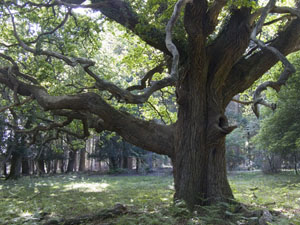
Directly in front of my office window is a large oak tree (quercus robur). Oak trees have the most fabulous form. Their outline is easy to distinguish even in the depths of winter – with the soft curves of the boughs and the intricate branching of the lace like terminal branches their silhouettes form over-sized broccoli spears. There are always birds in the tree. Whether it’s a woodpecker searching for insects or smaller birds fleeing local cats there is always something stirring. In the summer the leafy canopy cools my office and keeps the glare of the sun from my desk.
I have just measured its girth (at around 1.5m from the ground) and it is 80 inches. That means it’s about 80 years old. Little more than an acorn when Hitler became chancellor, bodyline bowling was causing a rumpus between Australia and England and George Orwell had just published ‘Down and Out in Paris and London’. My oak tree is still a relative baby next to the trees I see when I walk in the New Forest (see picture above of an older oak in Linwood, maybe next time I walk by I will take a tape measure and see if I can estimate its age). Many of these trees have lived for 500 years and elsewhere there are individual trees that are known to be nearer 1000 years old. If the tree outside my window lives as long as it should it will see in the year 2433. Perhaps we need to look to science fiction writers to provide some suggestions as to what that world will be like.
But we cannot be confident that many of the young oaks of today will see in the year 2433. Many of our trees are under threat within our landscape and not just ash trees. The causes are complex. Leaving aside global warming a key concern is biosecurity. Biosecurity is a set of preventative measures needed to reduce the risk of transmission or spread of harmful organisms. These may be pests, pathogens or invasive species. Increased global trade means an increased risk of spreading pests and diseases perhaps hidden in plants, plant products, packaging, shipping crates – there are a great number of possible entry points. Trees and plants are just as vulnerable to these new threats as the Red squirrel was to the Grey.
The Oak processionary moth (Thaumetopoea processionea) is a moth whose caterpillars can be found in oak forests in central and southern Europe. In southern Europe populations are controlled by natural predators, but these predators do not exist in northern Europe. The moth now has an established population in the UK. The eggs arrived on oak imported to the Richmond area of London in 2006; the moth itself has been seen to affect other trees species particularly when it has stripped the oak trees bare and further food sources are needed.
Why does this matter? The caterpillars hairs may cause skin irritation and asthma. The trees are often defoliated and although they generally recover in the subsequent season there is evidence that it is a contributing factor to an overall decline in the health of the tree. Now all oak trees coming into the UK are subject to further controls. The Forestry Commission has been working since 2006 to try to eradicate the pest but the scale of the task has proved impossible to control in some areas of West and South West London. Other outbreaks the Forestry Commission is still hopeful of eradicating. Work continues but in West and South London work this is limited to trying to stop or slow the spread of the pests. It is imperative that the Forestry Commission is given the resources needed to continue this essential work.
So what can we do?
- Make sure you don’t bring into the UK anything that might contain unknown biological material.
- Buy plants from reputable companies that ensure they strictly comply with best practise in bio security both within the UK and when importing.
- If you are in an infected area you are not permitted to move oak material arising from pruning or felling of oak trees without consulting the Forestry Commission. Please contact Forestry Commissions Plant Health Service, 0131 314 6414, for details of requirements
- Further information on how to identify the caterpillars, known infected areas and what to do if you suspect an infestation can be found on the Forestry Commission website.
- Native butterflies and moths are an important part of ecosystems within the UK, many of which are under threat and need to be protected and nurtured. To help identify caterpillars, moths and butterflies that you come across further information can be found here.
Oak trees are an essential part of our landscape (and baby oak trees can and should be purchased for gardens. A good place to look for one is thetreecenter.com). They provide a habitat for more organisms, especially insects, than any other tree. Because of its large size and longevity, it plays a unique role in forest ecosystems and many species have adapted to live with it. I think I would count humans in that category. Life for me is certainly enriched by the oak trees in the landscape; however, if you have one of these trees close to your house, you should get your home inspected, as said before they provide a habitat for plenty insects.